Born
December 15, 1911
in Wichita, Kansas, Stanley Newcomb Kenton grew up in Bellflower,
California; a suburb of Los Angeles Sometime around the age of 8, his
mother, Stella, a classically-trained musician noticed her son's
irrepressible aptitude for the piano and became his first teacher.
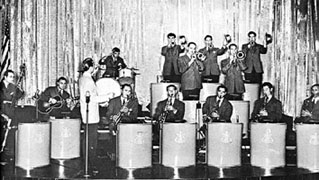 It
wasn't long, however, before she realized he was graced with more than
a natural gift for the keyboard and arranged for him to take lessons on
the trumpet and alto saxophone from a local school bandmaster, who
quickly
noticed his ambitious, lanky protege had a talent to be reckoned
with. It
wasn't long, however, before she realized he was graced with more than
a natural gift for the keyboard and arranged for him to take lessons on
the trumpet and alto saxophone from a local school bandmaster, who
quickly
noticed his ambitious, lanky protege had a talent to be reckoned
with.
It soon
became apparent
to everyone young Stanley came in contact with that the intricacies of
harmony, theory and counterpoint came easily to him and that he had no
trouble at all assimilating and then elaborating upon the imaginative
and
unorthodox
constructions used by the leading European Impressionists of the day;
Claude
Debussy, Maurice Ravel, Arnold Schonberg and Igor Stravinsky, all of
whom
he later celebrated in many of his own classically-inspired
compositions:
'Theme For Sunday,' 'Sunset Tower,' 'Concerto To End All Concertos.'
Upon
graduation from
Bell High School he worked during the day as a rehearsal pianist in
dance
halls and theaters. At night he paid his dues in a succession of
after-hours
bars, clip joints and five dollar-a-night speakeasies prevalent
throughout
the depression-era southwest until he was able to assemble his own
14-piece
orchestra in June of 1941. A dominant characteristic of this relatively
small Kenton Orchestra was the choppy, staccato manner of phrasing that
was especially noticeable in the writing for the reed section. In
retrospect
this continues to emerge as one of the most readily identifiable of all
the Kenton ensembles. His early piano voicings, slightly reminiscent of
ones used by the great percussion pianist, Earl 'Fatha' Hines,
gradually
found their own distinctive style when he reshaped his chord patterns
and
began adding augmented and diminished 5ths, 9ths, 11ths and 13ths,
which
began showing up in his arrangements.
Much
of the original library, written by Stan, permanently changed the sound
of big bands. Fiery, stratospheric brass, punctuated by explosive Latin
and Afro-Cuban rhythms pushed the time sequences to Mach One and became
a hallmark of the Kenton Orchestra. As cerebral a band leader as
popular
music has ever had, Kenton loved giving his Orchestra's titles.
He called his
first Orchestra, 'Artistry In Rhythm' which he stayed with for the next
seven
years. Then, without any advance notice, he broke up the Band and spent
the next six months orchestrating a new sound which he called
'Progressive
Jazz. ' It was as though he had heard other bands catching up with him
and had determined to move even further out. The rhythms were wilder,
the voicings of the saxophone and trumpet sections more frenetic, the
melody
and the beat more obscure. It was during this time that Kenton added
maracas,
bongo conga drums and the Spanish guitar dazzling finger-style of Brazilian-born
Laurindo Almeida to the Orchestra. Without a doubt Kenton's long-term
fascination with South American rhythms and themes produced some of his
most colorful and durable music, notably 'Cuban Fire' composed and
arranged by Johnny Richards in 1956.
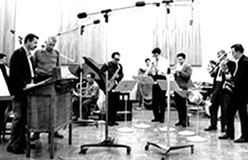 By 1948 the
compositions
Stan had written for 5 trumpets, 5 trombones, 5 saxophones and 4 rhythm
had
become an arresting, dominant force in contemporary music. Jazz
aficionados
from Southern California's Balboa Beach Rendezvous Ballroom to
New
York City's famed, subterranean Jazz club, Birdland, became
enamored
with the Orchestra's roaring, precision sound and helped make it one of
the most successful attractions in the entertainment industry. In June
of that year he filled the Hollywood Bowl with 15,000 people
and
sold out a midnight Carnegie Hall performance which included
300
folding chair placed on the stage alongside the Orchestra to
help
accommodate
the overflow. By 1948 the
compositions
Stan had written for 5 trumpets, 5 trombones, 5 saxophones and 4 rhythm
had
become an arresting, dominant force in contemporary music. Jazz
aficionados
from Southern California's Balboa Beach Rendezvous Ballroom to
New
York City's famed, subterranean Jazz club, Birdland, became
enamored
with the Orchestra's roaring, precision sound and helped make it one of
the most successful attractions in the entertainment industry. In June
of that year he filled the Hollywood Bowl with 15,000 people
and
sold out a midnight Carnegie Hall performance which included
300
folding chair placed on the stage alongside the Orchestra to
help
accommodate
the overflow.
Long
before
the Rock
phenomena overtook the United States the Kenton Orchestra was obligated
to keep moving to larger venues in order to accommodate its ever
increasing
number of enthusiasts who thought nothing about traveling hundreds of
miles
in order to listen to the band for just one short, exhilarating
evening.
In 1953, when the Band was playing its first European tour but was
unable
to work in England, the London Melody Maker arranged for the
chartering
of a dozen planes, as well as a special Kenton boat excursion across
the
Irish sea that took Jazz-starved fans to Dublin. More than half the
audience
of 7000 that jammed the Royal Theatre had come over from England
at a cost to many of two or three weeks' salary.
Critics
on
the other
hand either loved or hated the 'Artistry In Rhythm' Orchestra. More
often
than not they were venomous in their cheeky critiques of the
imaginative
shoulder-shaking arrangements Stan and his young alter ego and
protégé,
composer/arranger Pete Rugolo kept adding to the library each time the
band went out on the long road tours that wound throughout the United
States,
Canada, Mexico and in and out of the capitals of Europe. Paradoxically,
experts who had spent much of their time castigating Kenton's and
Rugolo's
early efforts to shatter traditional and constricting time barriers later rarely acknowledged the
two orchestrators
had incorporated off-beat meters into Jazz long before Don Ellis took
up
the quest.
It was
while
the Orchestra
was in England during the 1956 tour (the Kenton Orchestra was the first
American entertainment group permitted by the British Musicians Union
to
tour that fabled land of Kings and legends since World War II), that
Stan
scored several original sequences for the Sadler Wells Ballet Company,
along with composing the music for a grandiloquent ballet, featuring
the
Russe de Monte Carlo Company, commemorating Grace Kelly's Royal wedding
to Prince Rainier of Monaco.
Upon his
return to the
United States he learned he was the 3rd member to be elected to the
Down
Beat Jazz Hall of Fame; an honor established for a select few of
outstanding musicians
who had contributed the most to Contemporary American Music in the 20th
Century. Subsequently he won the Playboy Jazz Poll in the leader
category
six times and three Grammy Awards for 'West Side Story,' 'Adventures in Jazz'
and 'Adventures In Time.'
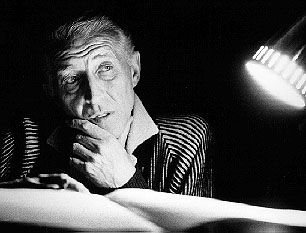 Kenton's
boundless energy and determination to experiment (one of his detractors
referred to it as an 'ecclesiastical obsession') with a mosaic of
complex
musical architecture and odd meters enabled the Orchestra to
continually
broaden its creative horizons. Over the years, it also cost him a cadre
of fans who felt confused and betrayed when he steadfastly refused to
honor
their requests to play 'Concerto To End All Concertos', 'Eager Beaver,'
'Interlude,' 'Lover,' 'Opus In Pastels' and 'Minor Riff;' all the
inventive,
crowd-pleasing scores, using flatted fifths, sevenths, ninths and
elevenths
long before the Bop Era began tearing it up along New York City's famed
52nd Street, that had set the Kenton Orchestra a millennium apart from
the more bouncy, 'lickety-split' sound of bands synonymous with the
Swing
Era. Kenton's
boundless energy and determination to experiment (one of his detractors
referred to it as an 'ecclesiastical obsession') with a mosaic of
complex
musical architecture and odd meters enabled the Orchestra to
continually
broaden its creative horizons. Over the years, it also cost him a cadre
of fans who felt confused and betrayed when he steadfastly refused to
honor
their requests to play 'Concerto To End All Concertos', 'Eager Beaver,'
'Interlude,' 'Lover,' 'Opus In Pastels' and 'Minor Riff;' all the
inventive,
crowd-pleasing scores, using flatted fifths, sevenths, ninths and
elevenths
long before the Bop Era began tearing it up along New York City's famed
52nd Street, that had set the Kenton Orchestra a millennium apart from
the more bouncy, 'lickety-split' sound of bands synonymous with the
Swing
Era.
On more
than one occasion
Stan drolly confided to friends: "I've lunged too far ahead! I've been
told, and I believe it, if I had stayed with 'Artistry In Rhythm' and
had not
moved so quickly into another phase, 'Progressive Jazz,' we would have
had the biggest commercial success of any band the country had ever
known
and I probably would have been a millionaire many times over. I also
would
have been bored out of my skull and no doubt ended up on some 'pillow
farm'
somewhere high atop the Hollywood Hills."
Anyone
who
was following
the band at this time knew he was sincere about continuing to seek out
new and innovative ways to make the Orchestra sound as exciting and
contemporary
as possible. In the summer of 1950 he added a full string section,
along
with oboes, French horns and bassoons to the basic 'Progressive Jazz'
setup
which increased the Orchestra's complement of 19 sidemen to 44
(outfitted
in formal wedding attire); commissioned a program of classical,
impressionistic
compositions fused with Jazz harmonies to be written and titled it
'Innovations
In Modern Music.' If Stravinsky and Darius Milhaud had seemingly been
working
to bridge the gap from classical music to Jazz, Kenton and his
arranging
staff seemed to be working on the same bridge, proceeding from the Jazz
side of the crevasse.
This
provocative next
step along the Orchestra's musical continuum, although hailed as a
critical
success, was a financial failure. Nonetheless it clearly demonstrated
Stan
Kenton's unerring ability to meld symphonic elements with contemporary
Jazz. It also served as an incubator for a vast repertoire of classical
concert pieces that continually flowed into the library for the next 30
years and was a showcase for a legion of extremely talented musicians.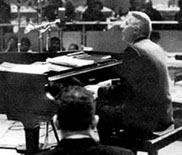
Two
decades
later he
again combined the 'New Era In Modern Music' 19-piece Jazz Orchestra
with
acres of strings, French horns, woodwinds, flutes and a megatherian
timpani
section. 'The Los Angeles Neophonic Orchestra', as it was rather pedantically
mislabeled,
played to capacity, standing-room-only audiences at the Los Angeles
Music
Center where it received high acclaim from a responsive audience
comprised
of Kenton enthusiasts, musicians, musical educators, the media (even
Leonard
Feather gave it a glowing review) and people who just loved to listen
to
great music.
However,
due
to enormous
financial constraints and the transcontinental nightmare involved with
moving such a husky organization from city to city, the Neophonic
Orchestra
was disbanded after less than a dozen performances. It also was the
catalyst
that ended Stan's 25-year relationship with Capitol Records who, for some
inexplicable reason, refused to record the Neophonic Orchestra live at the Music
Center. The one album that was recorded in a studio setting hardly
captured
any of the driving intensity and flashing solo work which brought the
audience
to its feet after each number.
In the
summer of 1960,
while the Orchestra was in residence at Indiana University at one of
the
many week-long music camps Stan conducted for young students from
colleges
across the country, he became disenchanted with the sound the Kenton
Orchestra
was projecting and at Gene Roland's urging decided to add an additional
five E-flat trumpets to the five B-flat section. After determining that
a brace of ten trumpets fell far short of capturing the kaleidoscope of
rich tonal colors he was seeking he and composer Johnny Richards, who
headed
up his arranging staff during the late 1950s and 1960s, worked closely
with Conn Instrument to develop a new instrument: the
Mellophonium.
A
brass
instrument,
keyed in F, which slightly resembles an unbent French horn, the 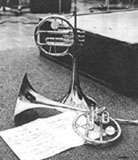 mellophonium
picked-up a spectrum of sound that had lain virtually untouched between
the trumpets and trombones. With a range a fifth below that of the
trumpets
the mellophoniums gave the ensemble passages a sonorous richness never
before heard or anticipated. On March 29, 1961 the 'New Era In Modern
Music'
Orchestra - built around a mellophonium library of Kenton, Holman,
Richards,
Niehaus and Roland scores - was premiered at the Riviera Hotel in Las
Vegas.
An early indication of its success was revealed when hotel management
swiftly
changed the room's tables and chairs to smaller ones following the
first
set in order to double the occupancy and send the whirr of the bar's
cash
register into quadruple over-time. mellophonium
picked-up a spectrum of sound that had lain virtually untouched between
the trumpets and trombones. With a range a fifth below that of the
trumpets
the mellophoniums gave the ensemble passages a sonorous richness never
before heard or anticipated. On March 29, 1961 the 'New Era In Modern
Music'
Orchestra - built around a mellophonium library of Kenton, Holman,
Richards,
Niehaus and Roland scores - was premiered at the Riviera Hotel in Las
Vegas.
An early indication of its success was revealed when hotel management
swiftly
changed the room's tables and chairs to smaller ones following the
first
set in order to double the occupancy and send the whirr of the bar's
cash
register into quadruple over-time.
After
three
years of
touring and eleven rather diverse recordings, including a Christmas
album
and an album of country & western songs done in collaboration with
cowboy singer Tex Ritter, both of which employed just the 14-piece
brass
and rhythm sections, Stan became restless and decided once again to
alter
the Band's format by abandoning the 4-man mellophonium section and
reworking
the 'New Era In Modern Music' Orchestra setup.
As expected,
this new
configuration of 5 trumpets, 5 trombones, 5 saxophones and 4 rhythm
underwent
a series of Kenton-inspired changes. The trombone section, comprised of
3 tenor and 2 bass trombones, was enhanced by one of the bass
trombonists
doubling on tuba which gave the section a brooding; medieval
sound. 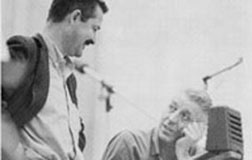
The
saxophone section,
built around the lead alto, was complemented by two tenors, a baritone
and bass sax. By anchoring all the bass instruments firmly beneath the
lead alto and trumpets Stan and his arrangers were able to create a new
'Adventure in Jazz:' a descriptive title he later used on several
albums
to define this extremely productive musical period marked by over 350
fiercely
original compositions.
"By
adding
more bass
to the bottom line we were able to stabilize it which kept the ensemble
work
from fragmenting as the five-man trumpet section soared high in the upper registers," he
explained
during a lengthy interview with TIME Magazine just before leaving on an
extended tour of the United States, Canada, Asia and Europe.
"We also
made the bass
player responsible for maintaining the time pattern, which in turn
enabled
the drummer to work at a different level so he could turn the beat
around
and back on top again using two, huge 28" Zildjian ride cymbals and a
variety
of very sharply-tuned snare drum patterns to make damn certain everyone
knew where 'One' was at all times.
"No easy
task, " he
laughed, "Hell, in one Holman concert arrangement Willis changed time
signatures
three times! Talk about staying focused for nine and a half minutes; I
was
afraid to breathe for fear I'd drop a beat and all hell would break
loose!"
An
iconoclast of the
first degree, Stan always believed in looking to the future. In fact,
one
of his often heard comments to the band was: "Never look back. It's
lost
energy." He abhorred nostalgia and reminiscing about the past which, no
doubt, accounted for his refusal to play any request which was not in
the
library other than his theme, 'Artistry In Rhythm,' 'Peanut Vendor' and
'Intermission Riff'.
As far
as
Stan was concerned
the long, historic road the Kenton Orchestra had traveled for close to
four decades was not to be tampered with. It is also generally agreed
that
it was the arranging staff under his ever discerning leadership who
kept
urging the Orchestra to keep moving forward and conquer a brave new
world
of dazzling harmonies, intricate time changes and maddeningly demanding
ensemble shifts. Although much of the library was a showcase for
original
writing, the Kenton Orchestra demonstrated time and again it was in a
class
by itself when it came to sculpting ballads with impeccable taste and
sensitivity.
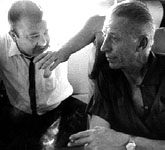 Stan's
sensuous arrangement of 'Street of Dreams' and Dee Barton's poignant
and
haunting constructions within 'Here's That Rainy Day' are but two of
the
timeless standards that made the Kenton Orchestra a favored attraction
at over 1500 college and university alumni homecomings and proms. Time
and again, couples would come up to him and say: "We fell in love
dancing
to 'I'm Glad There Is You, ' " or "Our son was conceived one evening
listening
to 'Moonlight In Vermont. ' " Although these intimate revelations
secretly
pleased him they also embarrassed him beyond words. More often than
not,
he would mumble a quick 'Thank You', turn aside and beat a hasty
retreat
back to the bandstand. Stan's
sensuous arrangement of 'Street of Dreams' and Dee Barton's poignant
and
haunting constructions within 'Here's That Rainy Day' are but two of
the
timeless standards that made the Kenton Orchestra a favored attraction
at over 1500 college and university alumni homecomings and proms. Time
and again, couples would come up to him and say: "We fell in love
dancing
to 'I'm Glad There Is You, ' " or "Our son was conceived one evening
listening
to 'Moonlight In Vermont. ' " Although these intimate revelations
secretly
pleased him they also embarrassed him beyond words. More often than
not,
he would mumble a quick 'Thank You', turn aside and beat a hasty
retreat
back to the bandstand.
Another
important dimension
to this Orchestra, the last Stan led before his untimely death in 1979
from an aneurysm he incurred during a fall in Philadelphia, was his and
Bill Holman's implementation of their intricate 'hidden note concept.'
Simply
stated, he and
Holman ascertained that if a given set of chord sequences was
meticulously,
precisely arranged a heretofore silent note would 'glide-in' and be
heard
deep within the primary chord. The immense power unleashed by this
dazzling
discovery produced lush cascades of orchestral sound that one music
critic
poetically referred to as 'Kenton's sweet sound of thunder.'
During
their
3-week
long engagement at Basin Street East in New York City another
critic
wrote: "Last night the excitement and energy generated by the Stan
Kenton
Orchestra blew the west wall of Basin Street East 15 feet into
the
kitchen area!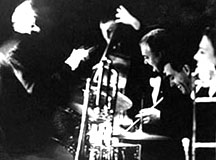 "Never before has a big band displayed such an enthusiastic command of
its library! I urge you to see Stan Kenton's dynamic musical centurions
in action. It's an evening I assure you, you'll long remember."
"Never before has a big band displayed such an enthusiastic command of
its library! I urge you to see Stan Kenton's dynamic musical centurions
in action. It's an evening I assure you, you'll long remember."
Interestingly
enough, the prodigious output of original compositions and arrangements
written by Stan, Dee Barton, Hank Levy, Bill Holman, Ken Hanna, Gene
Roland,
Johnny Richards and numerous other arrangers, who were quite willing to
help him push the creative edge as far as they dared, continue to be
employed
as teaching aids in many of the major universities and music schools
throughout
this country and Western Europe.
Especially
interesting
to musical educators is the effortless manner in which the Kenton
arranging
staff deftly tempered a stunning array of iridescent harmonies against
such complex and formidable time meters as 5/4, 7/4, 12/8 (divided
3+3+2+2+2+2),
13/8, 14/8 (divided 2+2+3+3+2+2), 6/8 and 9/8. 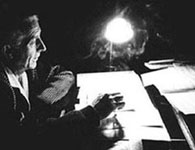 Many
also consider the trombone choral patterns worked out by Stan in
collaboration
with lead trombonist Bob Fitzpatrick established a creative milestone
that
has been slavishly imitated yet never equaled. Night after night,
Fitzpatrick's
big, buoyant lead notes opened up a blazing doorway for the rest of the
Orchestra to stride through and gallantly march across a musical
landscape
that was ever evolving. There would be no turning back. Ever! Many
also consider the trombone choral patterns worked out by Stan in
collaboration
with lead trombonist Bob Fitzpatrick established a creative milestone
that
has been slavishly imitated yet never equaled. Night after night,
Fitzpatrick's
big, buoyant lead notes opened up a blazing doorway for the rest of the
Orchestra to stride through and gallantly march across a musical
landscape
that was ever evolving. There would be no turning back. Ever!
Believed
to one
of the most creative Jazz artists to have performed in the last 50
years
(even his most vocal critics agreed he was a brilliant composer and
arranger),
Stan Kenton has left us with a musical legacy that quite possibly will
never be equaled.
At least
not in our lifetime.
Even now, 20
years after
his death -- August 25, 1979 -- his music is as fresh and imaginative
as
the
day it was first performed in 1942. What's more, the undeniable 'Kenton
Touch'
graces each of the more than 2500 scores written for the Orchestra by
Stan
and the two dozen or more extremely talented composers and arrangers
whose
list of musical credits reads like a Who's Who of the Jazz World.

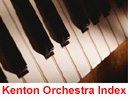
|